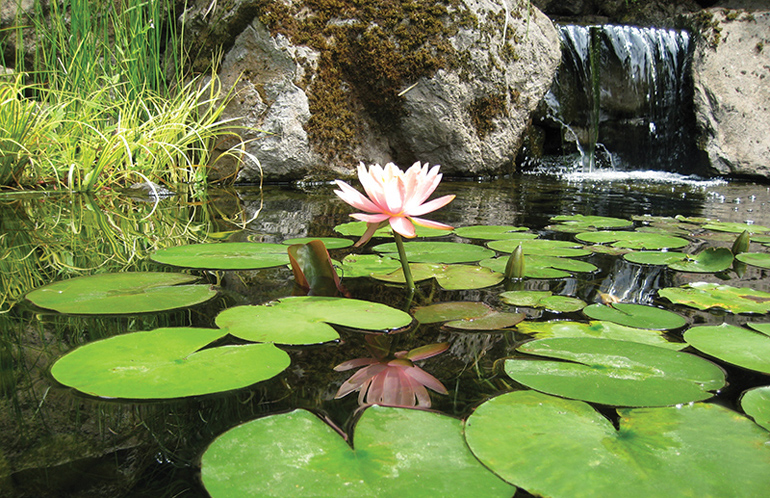
Choosing a proper water filtration system is a critical step in water-feature construction. It relies on understanding your customer and their budget, pond conditions and requirements. Proper planning can deliver clean, clear, healthy water, help to work within your budget and live up to the end user’s expectations.
Understanding the features, benefits and drawbacks of each pond filtration system is the first step. When selecting a filtration type —“ mechanical, biological and ultraviolet clarification (UVC) —“ you must weigh the options. Every pond has multiple filtration possibilities, and each type of filtration is ideal for certain conditions. Consider efficiency, maintenance, cost, appearance, reliability and the customer’s expectations when deciding which filtration type to use.
Types of Filtration
In mechanical filtration, water passes through filter media, removing particles from the water. Media are rated to filter particles of varying sizes. The flow rate determines the speed of water flow through the filter. Efficient filtration relies on proper selection of filter media and flow rate. Common types of mechanical filters are those that utilize pressure and gravity as the method of moving water through the filter.
Biological filtration relies on the nitrogen cycle, or naturally occurring beneficial bacteria that convert nitrites and ammonia to less toxic nitrates. Biological filtration relies on an oxygen-rich area for bacteria to grow. Establishing a biological filter can take four to six weeks, so keeping the pond in balance as it establishes its natural rhythm may require some attention. Ammonia and nitrite levels may spike, impacting the health of fish. Water changes and aeration can mitigate the impact of the natural process.
Finally, ultraviolet clarifiers work by damaging microorganisms like algae at the cellular level. Once damaged, single-cell algae clump together and either are captured by the filter or settle on the pond’s bottom. UV clarifiers can be added to a filtration system for additional support, but often times they can be found integrated into the filtration products themselves.
Filtration Systems
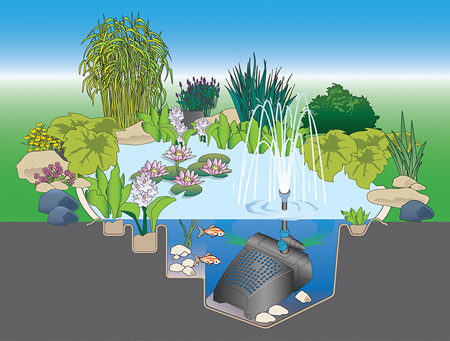
Using mechanical and biological filtration, and in some cases UVC, in-pond filters are built for ponds that are usually no more than 1,000 gallons. Most are self-contained units comprised of a pump, filter and some sort of water display. An in-pond system is typically easy to install, but it’s important to note that there are size limitations and maintenance requirements to consider when using them.
Skimmer and waterfall systems are another filtration configuration to consider. These are comprised of a skimmer unit located at the side of the pond and a waterfall housing that is typically located opposite the skimmer. This is a multifunctional setup, supporting mechanical and biological filtration, as well as aeration for a clearer pond. The filtration in this system is handled in either the skimmer or in the waterfall. While they are easy to install, a skimmer and waterfall filter systems can have some drawbacks. The maintenance can be something that end users don’t enjoy, because they may have to remove the media for cleaning, or perhaps access to the media is not otherwise convenient. Another issue with this type of system is that if filter media get clogged in the skimmer, the water level in the pump area of the skimmer will drop, leading to pump burnout.
Another system to consider is pressurized filtration, which uses the water pressure developed by the pond pump to push water through an enclosed filter housing with media in it. It then filters the water and returns it to the pond. One of the benefits of a pressurized system is that water returned to the pond can be directed to a waterfall or water feature located above the elevation of the filter. Many of the pond-style pressure filters can be partially buried, making them easier to conceal around the pond. Pool-style pressure filters, which are sometimes called sand filters or bead filters, can be more difficult to conceal.
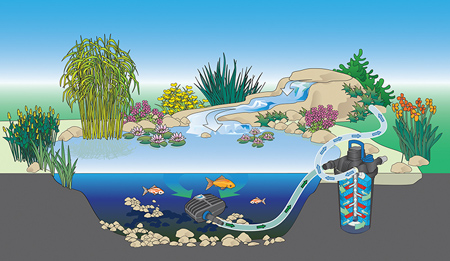
When choosing a pressure filter, it is important to understand the media that are being used. Filter foam is one of the best ways to mechanically stop debris, because it physically stops debris from re-entering the pond system and promotes the growth of beneficial bacteria. Beads or bio-balls are another media that is popular because they typically offer a large amount of surface area that promotes the growth of beneficial bacteria. The downside to bead-style filters is that they don’t typically do a great job of mechanical removal of debris and they can use a large amount of water during the cleaning process.
Bog and underground filters represent additional options. Bog filters are typically constructed with liner and connected to the pond. A pump from the pond delivers water from the pond into the bog, and then gravity moves water through bog media —“ usually pea gravel —“ and returns it to the pond. An undergravel filter is usually constructed with a system of perforated pipes in the bottom of the pond covered with gravel or rock. The perforated pipe is connected to pump, which either pushes or pulls water through the gravel. The gravel promotes the growth of beneficial bacteria. The downside to both of these systems is that eventually they need to be cleaned out, which can be a fairly significant job.
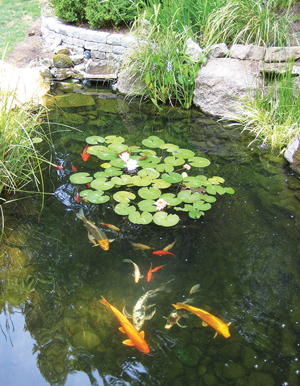
Finally, you might consider flow-through and gravity filters, which use gravity to pull the pond water through the filter. In a flow-through filter, a pump forces water into the top of the filter, which then flows through various forms of media, including foam pads, brushes and mesh screens, all via gravity. This type of filter is located at the highest point of the system. The clean water is then delivered back into the water feature. These can be ideal for any water garden or koi pond, creating cleaner and clearer water as it flows through the media. The downside to this type of systems is that they can be more difficult to mask in the landscape.
Gravity filters differ in the elevation of the filter and the placement of the pump. The filter is located so that the water level in the filter is the same as the water level of the pond. The pump is located at the end of the filtration system and sends water out of the filter and back into the pond. Pumping water out of the last stage of the filter forces gravity to pull pond water into the first stage of the filter. This a very effective and efficient method of filtration, but again, the downside is that locating the filters can be challenging on some projects.
The Pond’s Workhorse
The pump, or the “pond’s workhorse,” supports the filtration system. Pumps come in a variety of styles and sizes, and it is important to choose the correct pump for the filtration system. A solids-handling pump is recommended for any installation that requires the pump to pass debris through it and into the filter.
Multiple options and combinations can make choosing a filtration system an arduous task. Begin by understanding the need based on pond conditions and identifying filtration systems to suit. Next, eliminate options based on the budget. Finally, consider the fit between system and customer, choosing a system that accounts for the customer’s lifestyle and resources.
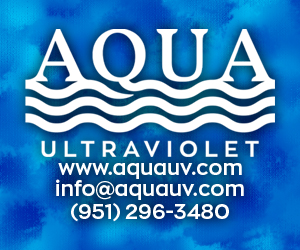


Any advice on solar powered pumps? Are they feasible for a 30,000 gallon pond?
That’s a lot of volume for Solar Unless you run it with air-lifts. With a properly designed air-lift system you can run about 10,000 gph through filtration with one amp of electricity. For 3 amps you could turn it over once an hour.
Any advice for a 562,158 gallon pond, which biological filtration system to choose? gravitational, pressurized, or an aeration system with bacterial dosage?